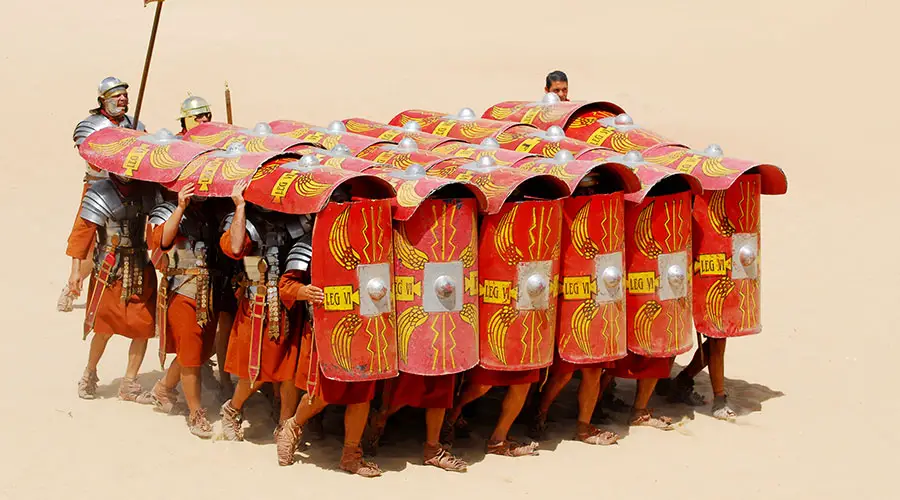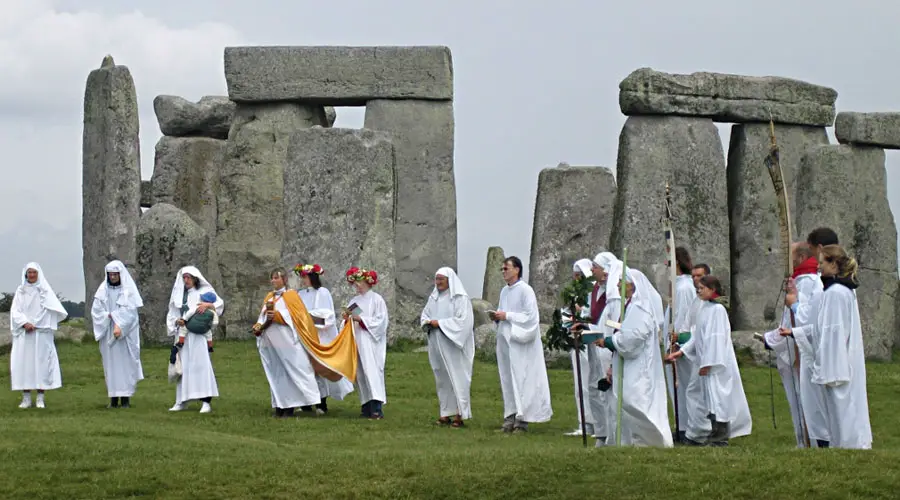When Julius Caesar and the Roman army conquered the Gauls, Caesar encountered the Druids, the priestly class of the Gauls, who made a dramatic impression on him.
Julius Caesar encountered the Druids during the Roman conquest of the Gauls, and was fascinated by them and their practices. He expressed this perspective in his books on the wars with the Gauls. He also considered them a threat to Roman rule, eventually suppressing Druidism.
The Druids continued to perform their rituals in secret under Roman rule, which Caesar allowed to happen, despite his respect and concern for the knowledge and ways of the Druids.

Julius Caesar Wrote about the Druids in his Book “The Gallic War”
In it, he described the Druids as the intellectual class of the Gauls (modern-day France) who held a great deal of power and influence in society. He wrote that the Druids were responsible for religious worship and ceremonies, and that they also served as judges in legal disputes. Caesar also wrote that the Druids were known for their knowledge of natural science and astronomy, as well as their use of the Druidic script, which was used to preserve their teachings and laws.
Caesar was fascinated by the Druids and their practices, but he was also wary of their power and influence. In his accounts, he portrayed the Druids as a threat to Roman rule in Gaul, and he eventually took measures to suppress the Druidic religion and culture.
Of particular interest to Caesar was that the Druids seemed to already possess several Roman deities in their pantheon. He found that they already adored Mercury, Apollo, Mars, and Jupiter, leading to much speculation as to the source of their knowledge. It has been suggested that the Druids may have learned their magic from Phœnician navigators who established colonies in Britain, thousands of years earlier while searching for tin. Others have suggested that the origins of the Druids knowledge could be traced back to Asia, and were of a Buddhist nature.
The Romans and the Gauls
The interactions between the Romans and the Gauls were complex and varied over time. At the beginning of the Roman conquest of Gaul, the Romans and Gauls were in conflict, as the Romans sought to expand their empire and the Gauls sought to protect their independence and way of life.
During Julius Caesar’s conquest of Gaul, the Gauls fought several wars against the Romans, but they were eventually defeated. After the conquest, Gaul became a Roman province, and the Gauls were assimilated into Roman culture and society to varying degrees. Some Gauls adopted Roman customs and ways of life, while others held onto their native culture and traditions.
Despite the Roman conquest, there were still tensions between the two cultures, and several uprisings and revolts took place over the years. However, over time, the Gauls and Romans became more integrated, and a hybrid culture emerged that combined elements of both Roman and Gaulish traditions.
In general, the interactions between the Romans and Gauls were marked by conflict, assimilation, and eventual integration, reflecting the complex and dynamic nature of their relationship over the centuries.

Druidism during the Roman Conquest
Druidism was an important part of Gaulish culture and history, and it played a significant role in the spiritual and intellectual life of the Gauls. Druidism was a nature-based religion that was centered around the worship of natural forces and the cycle of life, death, and rebirth. Druid priests, known as Druids, were highly respected and held significant power and influence in Gaulish society. They served as spiritual leaders, mediators, judges, and teachers, and they were known for their knowledge of natural science, astronomy, and the Druidic script.
The teachings of the Druids was divided into two groups. The Simpler group was a moral code, which was taught to everyone in Gaulish society. The Druids taught that the soul is immortal, and reincarnates in order to learn more life lessons.
The second group was the esoteric teachings only revealed to initiated priests, who were bound to secrecy. They were taught in amongst the trees of the forest, and at times in caves, and learned about the creation of the universe, the personalities of the gods, and the laws of nature.
The Gauls maintained their Druidic beliefs and practices throughout the Roman conquest of Gaul, and although the Roman authorities attempted to suppress the religion, it persisted for several centuries. Over time, however, Druidism declined as Christianity became the dominant religion in the region. Despite this decline, the legacy of Druidism lived on in various forms, including in the folklore and mythology of the Gauls and other Celtic cultures. Today, Druidism is still practiced by some people as a modern spiritual tradition, and its influence can be seen in various aspects of contemporary culture, such as literature, music, and art.
The Conquests of Julius Caesar
During his conquests, Julius Caesar encountered a variety of different belief systems, including many that were different from his own Roman religion. Some of the most notable belief systems that Caesar encountered in Gaul and other parts of the Roman Empire include:
Celtic religion: In addition to Druidism, the Gauls also practiced a variety of other religious beliefs and rituals that were based on their Celtic heritage. These beliefs often involved the worship of nature gods and goddesses and the use of sacred groves and other natural places for religious ceremonies.
Polytheism: Caesar encountered many cultures that practiced polytheistic religions, in which multiple gods and goddesses were worshipped. These gods were often associated with specific aspects of nature or human life, such as fertility, agriculture, or war.
Mithraism: This was a mystery religion that was popular among Roman soldiers and civilians. It was based on the worship of Mithras, a god associated with the sun, and involved initiation rites and secret ceremonies.
Judaism: Caesar encountered the Jewish people and their religion during his conquests, particularly in the region of Palestine. Judaism was a monotheistic religion that was based on the worship of one God and the belief in the sacred text of the Torah.
Other mystery cults: In addition to Mithraism, Caesar also encountered various other mystery cults and religions that were based on secret initiation rites and the worship of specific gods. These cults often offered a sense of community and a deeper understanding of the divine to their members.
These are just a few examples of the diverse array of belief systems that Julius Caesar encountered during his conquests. Despite the differences among these religions, Caesar was often tolerant of them and allowed them to continue, as long as they did not pose a threat to Roman rule.
The Writings of Julius Caesar
Julius Caesar wrote several books, but his most famous works are the “Commentarii de Bello Gallico” (Commentaries on the Gallic War) and the “Commentarii de Bello Civili” (Commentaries on the Civil War). The “Commentarii de Bello Gallico” is an account of Caesar’s campaigns in Gaul (modern-day France) from 58-51 BC, and it provides valuable insight into the Gauls and their culture, as well as the Roman conquest of Gaul. The “Commentarii de Bello Civili” is a first-hand account of the civil war between Caesar and the Roman senatorial party, which took place from 49-45 BC. Both works are considered to be classic examples of Latin prose, and they have been widely read and studied for centuries.
In addition to these works, Caesar also wrote several other books and speeches, including “Antiquitates”, “Rerum Memorandarum Libri”, and “Oratio”. These works have been lost to time, but they provide additional insight into Caesar’s life, thoughts, and actions.

Rituals of the Druids
The Druids performed a variety of religious rituals. Although these ceremonies were suppressed by Caesar, they continued to be performed in secret. Some of the most notable rituals included:
Sacrifice: The Druids performed animal and, in some cases, human sacrifices as part of their religious ceremonies. These sacrifices were often performed to appease the gods and to ensure a bountiful harvest or other favorable outcomes. In particular, the Druids would sacrifice white bulls under the mistletoe tree.
Healing rituals: The Druids were also known for their ability to perform healing rituals and to use medicinal plants in their treatments. They were considered to have a deep understanding of the natural world and were sought after for their ability to heal the sick and injured. There medicine involved the use of magnetism, and healed the astral body.
Nature worship: Druidic beliefs were centered around the worship of natural forces and the cycle of life, death, and rebirth. The Druids performed religious ceremonies in sacred groves and other natural places, and they honored the spirits of nature, such as trees and rivers, as well as the sun, moon, and stars.
Divination: The Druids were skilled in the art of divination and often used it to predict the future or to seek guidance from the gods. They used various methods, such as reading the patterns of clouds, the flight of birds, or the shapes of clouds, to gain insight into the divine will.
Initiation rites: The Druids had a complex system of initiation and training, and new members were required to undergo a series of rites and tests to become a full-fledged member of the priesthood. These initiation rites were often secret and involved physical, mental, and spiritual challenges. The Druids had three degrees of initiation: the honorary members wore green. The next level, the Bards, wore blue, and were tasked with memorizing Druidic poetry. The third and highest level were the Druids, who wore white. There were also the Arch Druids, the spiritual head of the organization. There would be two Arch Druids in Great Britain at a time, and the position may have been hereditary.
The beliefs of the Druids were described by writer James Freeman Clarke as follows: “the Druids believed in three worlds and in transmigration from one to the other: in a world above this, in which happiness predominated; a world below, of misery; and this present state. this transmigration was to punish and reward and also to purify the soul. in the present world, said they, Good and Evil are so exactly balanced that man has the utmost freedom and is able to choose or reject either. the Welsh triads tell us there are three objects of metempsychosis: to collect into the soul the properties of all being, to acquire a knowledge of all things, and to get power to conquer evil. There are also, they say, three kinds of knowledge: knowledge of the nature of each thing, of its cause, and its influence. There are three things which continually grow less: darkness, falsehood, and death. there are three which constantly increase: light, life, and truth.”
Recommended Reading
If you want to continue exploring this subject more deeply, you can see which books I recommend by clicking here.
